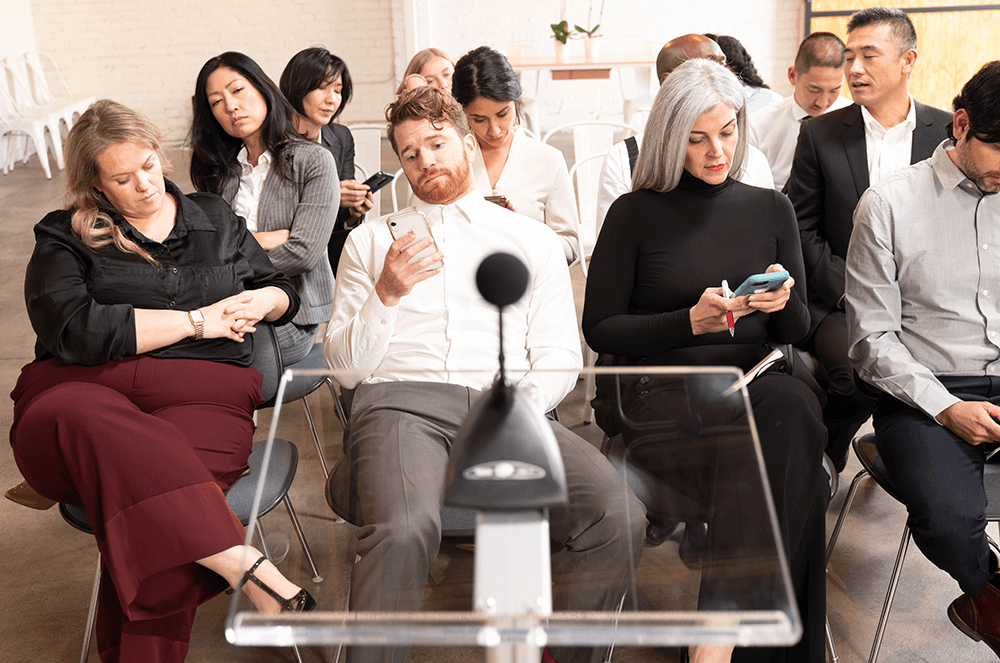
While giving a presentation to a group of sales representatives, I noticed their phones seemed to have a magnetic effect on their hands. Some seemed to be taking notes on their computers—but I had no way to tell if they were memorializing my brilliant ideas or catching up on their emails. I was speaking to them, ironically, about communication. They were genuinely interested in my topic, but they found it hard to concentrate. They were a distracted audience.
Distraction is here to stay. Research shows that people distract themselves every few seconds. Whether they are daydreaming or feeling the urge to grab their phone, they are not fully in the moment. The universal presence of smartphones and tablets provides an endless supply of diversions, ranging from emails to articles to that old standby, Candy Crush. Gone are the days when, as in the Lincoln-Douglas political debates in 1858, the audience sat attentively for hours while each speaker presented his case. Now we are lucky to get someone to go 10 minutes without looking at their phone. So how can we capture the audience before they pick up their device?
Classic Ideas for Capturing Focus
Plan your speeches to anticipate audience distractibility and use these tips to increase the likelihood that your audience will pay attention.
Put your main point first.
People are paying the most attention at the beginning of your message. Start with a hook that grabs their attention, such as a question, statistic, anecdote, or quotation. Then deliver the main message within the first two minutes to ensure it is received. Don’t start with history or background. Cut to the chase.Use clear, simple language.
If you simplify your speech to a primary school level, people will find you easier to understand. Even if you know that all your listeners are college grads, if you speak at a secondary-grade level (e.g., 12th grade), they are likely to disengage.Language level is a combination of sentence length and vocabulary. Vary the length and rhythm of your sentences but keep your average length low. Use short, familiar words in place of vocabulary that you think will make you sound smart. Instead of utilize, say use. Instead of taking it under consideration, say considering. Don’t say prior to; instead, say before.
How Can We Retain Our Audience’s Attention?
Even if you’ve prepared a knockout speech, your listeners are likely to feel twinges of distraction. Given the atmosphere we live in, how can we retain our audience’s attention?
First, realize that people pay attention to what they find valuable. Your audience will make a snap judgment when you begin speaking, deciding whether your material will benefit them. Demonstrate unequivocally that listening to you is the best thing they will do all day.
Even after you have won your audience members’ attention, you will have to work to keep them engaged. Marianne Fleischer, speechwriter and presentation skills coach at Fleischer Communication, has decades of experience helping presenters lasso the wandering listener. She points out that most people have an “automatic guessing machine”—they believe they know what you are going to say, so they don’t have to listen to you. She suggests that speakers disrupt this automatic process. Here are a few ways to re-engage your listeners.
- Ask a big question. Challenge your listeners by asking them a riveting question such as, “Why do you think we’re here today?” or “What do you think is the biggest cause of business failures in our society today?” Get them talking and let them share a bit of their own experience—they will then be more likely to listen to you.
- Tell a killer anecdote tailored to the audience: Always have two great, targeted anecdotes ready to go in case you need to bring back a distracted crowd.
- Change something. If you’re standing up, sit down. If you’re sitting, pop up from your chair. Walk around the room. Walk to the other side of the podium. Say something funny. Surprise them.
These tips will help you keep your listeners on their toes. When they don’t know whether you’re about to pop a question or call on them, they will be more alert.
Speaking to an Online Audience
The tips listed above will help you create powerful presentations, but challenges linger when speaking online. For example, it’s frustrating when people keep their cameras turned off. Speaking to a sea of black boxes does not inspire great performance.
If many people in your audience have turned off their video, point out that it is more respectful to other group members if people turn on their cameras. If you are a manager or instructor, you can say that having the camera on is required. When I present online writing training, I always call on people without cameras to answer questions first.
People pay attention to what they find valuable.
When people work on multiple screens as you speak, it’s tough to keep their attention. Multitasking is rampant despite research showing that it ultimately makes people less productive. People feel more productive when they are juggling six balls in the air, and they may be unwilling to let their other work wait while they listen to you. If I see someone looking down at their phone or at another screen, I call on them, asking them to answer a question or comment on something I have just said. We need to keep bringing them back to our presentation.
By accepting that some people are bound to be distracted during your presentation and preparing to deal with distractions, you will find it easier to keep your cool when someone in your audience pulls their phone out of their pocket and starts scrolling while you’re speaking. Provide solid value, put verve in your voice, and keep the audience on its toes: You’ll win back your listeners’ attention.
Elizabeth Danziger is founder of Worktalk Communications Consulting, an author of four books, and a columnist on Inc.com. She has taught business communication to companies throughout the United States for many years. You can reach her at lizd@worktalk.com. Her company sends out Writamins writing tips monthly. To receive them, sign up at worktalk.com.
Related Articles

Presentation Skills
Dealing with Distractions

Communication
Expect the Unexpected

Audience



 Previous
Previous

 Digital Detox
Digital Detox
 Previous Article
Previous Article